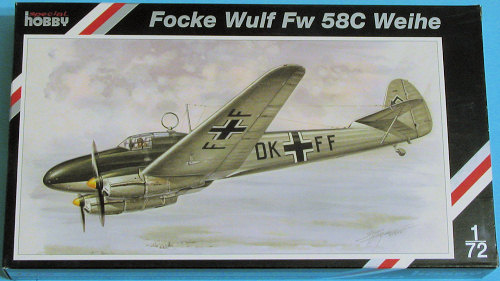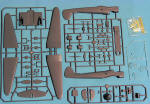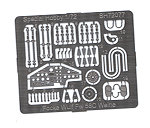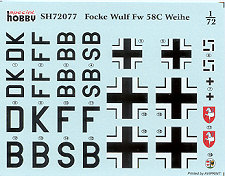
| KIT: | Special Hobby 1/72 FW-58C 'Weihe' |
| KIT #: | 72077 |
| PRICE: | $32.25 from www.greatmodels.com |
| DECALS: | Two options |
| REVIEWER: | Scott Van Aken |
| NOTES: | Short run with resin and etched metal parts. |

| HISTORY |
The FW-58 was designed to a specification requiring a communications aircraft and light bomber to be powered by two Argus 10C eight cylinder inverted vee air cooled engines. The other aircraft in the competition was the Arado Ar-77.
The aircraft was quite typical of the time with a welded steel tube fuselage wrapped with fabric or metal or wood. In this case the aircraft was only metal forward of the wing spar on the wings. The low set wing was braced by a large support that led from the upper fuselage to just inside the engines. The tail plane was high set and also braced. Retractable main gear went into a housing in the engine nacelle.
First flight was in 1935 and it was done in the light transport configuration carrying six passengers. The second prototype was the basis of the FW-58A series and had an open nose position with armament in the nose and dorsal position. Few A models were built before the B variant came into production. It had a glazed nose replacing the open gun position and was capable of carrying light bombs. Some B models were produced with floats. The major production version was the C model with a 'solid' nose and room for six passengers. It was used as a trainer, communications aircraft and air ambulance. The aircraft was also license produced in Bulgaria and Brazil with many surviving the war.
| THE KIT |
 Typical
for Special Hobby, the parts are well done with finely engraved panel lines and
a well done fabric detail on the fuselage. There is a full cockpit that makes
use of etched and resin parts for the various details. There are also some cabin
seats provided as is fitting for a light transport, though little will be seen
through the
Typical
for Special Hobby, the parts are well done with finely engraved panel lines and
a well done fabric detail on the fuselage. There is a full cockpit that makes
use of etched and resin parts for the various details. There are also some cabin
seats provided as is fitting for a light transport, though little will be seen
through the  small side window.
Though all the bits for the glazed nose are included, they are not used.
Similarly, on the skinny sprue with the solid nose, several parts there are also
not used, so you won't have to cut off the kit rudder to use the additional one
supplied. The resin and etched sprue are mostly for the interior though a
small side window.
Though all the bits for the glazed nose are included, they are not used.
Similarly, on the skinny sprue with the solid nose, several parts there are also
not used, so you won't have to cut off the kit rudder to use the additional one
supplied. The resin and etched sprue are mostly for the interior though a
 few bits are used externally, like
the DF loop antenna.
few bits are used externally, like
the DF loop antenna.
Instructions for this late 2004 kit are well done with a history section, parts layout and several well drawn construction steps. Color information is provided and for the inside bits are all generic. The camouflage colors are in what seems like Humbrol and some other company's colors (Agama?). RLM colors are also provided. Markings are for two planes. One is the box art plane from LKS 7 in 1943 in a most interesting scheme of RLM 71 over RLM 02 with yellow spinner tips. The other is a standard splinter camo of RLM 70/71/65 from 1943 as well with A/B 32 (a training unit). This one has yellow wing tip undersides and a yellow fuselage band. Decals are very nicely done by AviPrint and appear in perfect registration.
| CONCLUSIONS |
This kit will make into an impressively large aircraft and though not as fancy and swift as a fighter, is an aircraft that saw a great deal of service during the war and after. Besides the Karo-as kit, the only other kit of this plane in this scale was a vac and resin one. Surely this one has to be easier to build!
| REFERENCES |
Kit instructions and the internet.
January 2007
You can get this and other fine kits at GreatModels
If you would like your product reviewed fairly and quickly by a
site that has nearly 350,000 visitors a month, please
contact
me or see other details in the
Note to
Contributors.